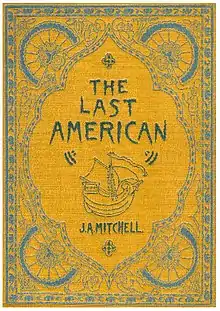
The Last American is a short illustrated future history novel by John Ames Mitchell (1845–1918).
Overview
First published in 1889, the novel is the fictional journal of a Persian explorer named Khan-Li, who sails across the Atlantic in 2951 and rediscovers America. Beginning around 1960, the world was devastated by drastic climatic changes, with North America becoming virtually uninhabitable; these had later partially reversed themselves, though the Persian explorers find the East Coast at the latitude of New York unbearably hot. Most of the narrative consists of a satirical and unflattering view of late 19th-century American society through the eyes of the Persians, who are simultaneously impressed by its grandeur and contemptuous of social developments Mitchell did not approve of; these included the equality of the sexes and the presence in America of the Irish, who apparently came to dominate it after a "Massacre of the Protestants" in 1927. During its final decades, the US had been ruled by a "Murphy Dynasty," with the Persians finding a late coin from 1957 bearing a harp on one side and the portrait of an Irish dictator on the other.
The 1893 edition is a small hardcover book with 78 numbered pages. It is illustrated with half-page etchings inserted into the text and a few full-page etchings. One shows a reconstructed street scene with "costumes and manner of riding... taken from metal plates now in the museum at Teheran"; clearly indicating newspaper advertisements from a print shop. Another, "The Wooden God," is a cigar store Indian; and "The Ruins of the Great Temple" shows a devastated Capitol Building.
Analysis
The book is, on the one hand, a satirical look at ways and customs of the United States as reconstructed from the ruins and the Persians' own spotty histories of the long-past era. It also seems to be a spoof of the archaeological discoveries that were being made at the time. All of the Persians have farcical names (Nōz-yt-ahl is the name of a historian, for example) and often speak in breathless wonder at what they see.
The Last American is among the anti-utopian disaster literature published in the late 19th century, along with Ignatius Donnelly's Caesar's Column and Park Benjamin Jr.'s The End of New York.[1]
Montesquieu's Persian Letters may have provided some degree of inspiration. In its own turn, the book seems to have been a rough model for Aldous Huxley's Ape and Essence.
Dedication
The dedication on the novella changed between the first edition in 1889 and the edition of 1902: the first through eighth editions have the following dedication:[2]
TO THE AMERICAN WHO IS MORE THAN SATISFIED WITH HIMSELF AND HIS COUNTRY THIS VOLUME IS AFFECTIONATELY DEDICATED.
...In the 1902 edition, this was changed to:[3]
TO THOSE THOUGHTFUL PERSIANS WHO CAN READ A WARNING IN THE SUDDEN RISE AND SWIFT EXTINCTION OF A FOOLISH PEOPLE THIS VOLUME IS DEDICATED
References
- ↑ Beck, Matthias and Beth Kewell. Risk: A Study of Its Origins, History and Politics. World Scientific Publishing Co., 2014: 85. ISBN 9789814579292
- ↑ The last American: A fragment from the journal of Khan-Li [pseud.]. Frederick A. Stokes. 1889. OL 7218176M.
- ↑ The Last American: A fragment from the journal of Khan-Li, prince of Dimph-Yoo-Chur and admiral in the Persian navy. F. A. Stokes company. 1902. OL 21930858M.